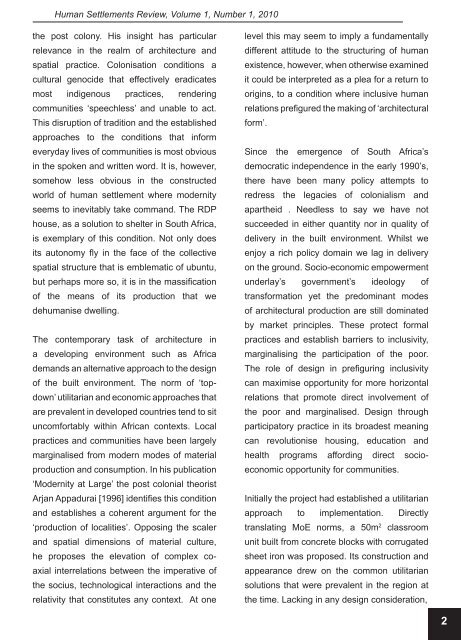Human Settlements Review - Parliamentary Monitoring Group
Human Settlements Review - Parliamentary Monitoring Group
Human Settlements Review - Parliamentary Monitoring Group
Create successful ePaper yourself
Turn your PDF publications into a flip-book with our unique Google optimized e-Paper software.
<strong>Human</strong> <strong>Settlements</strong> <strong>Review</strong>, Volume 1, Number 1, 2010<br />
the post colony. His insight has particular<br />
relevance in the realm of architecture and<br />
spatial practice. Colonisation conditions a<br />
cultural genocide that effectively eradicates<br />
most indigenous practices, rendering<br />
communities ‘speechless’ and unable to act.<br />
This disruption of tradition and the established<br />
approaches to the conditions that inform<br />
everyday lives of communities is most obvious<br />
in the spoken and written word. It is, however,<br />
somehow less obvious in the constructed<br />
world of human settlement where modernity<br />
seems to inevitably take command. The RDP<br />
house, as a solution to shelter in South Africa,<br />
is exemplary of this condition. Not only does<br />
its autonomy fly in the face of the collective<br />
spatial structure that is emblematic of ubuntu,<br />
but perhaps more so, it is in the massification<br />
of the means of its production that we<br />
dehumanise dwelling.<br />
The contemporary task of architecture in<br />
a developing environment such as Africa<br />
demands an alternative approach to the design<br />
of the built environment. The norm of ‘topdown’<br />
utilitarian and economic approaches that<br />
are prevalent in developed countries tend to sit<br />
uncomfortably within African contexts. Local<br />
practices and communities have been largely<br />
marginalised from modern modes of material<br />
production and consumption. In his publication<br />
‘Modernity at Large’ the post colonial theorist<br />
Arjan Appadurai [1996] identifies this condition<br />
and establishes a coherent argument for the<br />
‘production of localities’. Opposing the scaler<br />
and spatial dimensions of material culture,<br />
he proposes the elevation of complex coaxial<br />
interrelations between the imperative of<br />
the socius, technological interactions and the<br />
relativity that constitutes any context. At one<br />
level this may seem to imply a fundamentally<br />
different attitude to the structuring of human<br />
existence, however, when otherwise examined<br />
it could be interpreted as a plea for a return to<br />
origins, to a condition where inclusive human<br />
relations prefigured the making of ‘architectural<br />
form’.<br />
Since the emergence of South Africa’s<br />
democratic independence in the early 1990’s,<br />
there have been many policy attempts to<br />
redress the legacies of colonialism and<br />
apartheid . Needless to say we have not<br />
succeeded in either quantity nor in quality of<br />
delivery in the built environment. Whilst we<br />
enjoy a rich policy domain we lag in delivery<br />
on the ground. Socio-economic empowerment<br />
underlay’s government’s ideology of<br />
transformation yet the predominant modes<br />
of architectural production are still dominated<br />
by market principles. These protect formal<br />
practices and establish barriers to inclusivity,<br />
marginalising the participation of the poor.<br />
The role of design in prefiguring inclusivity<br />
can maximise opportunity for more horizontal<br />
relations that promote direct involvement of<br />
the poor and marginalised. Design through<br />
participatory practice in its broadest meaning<br />
can revolutionise housing, education and<br />
health programs affording direct socioeconomic<br />
opportunity for communities.<br />
Initially the project had established a utilitarian<br />
approach to implementation. Directly<br />
translating MoE norms, a 50m 2 classroom<br />
unit built from concrete blocks with corrugated<br />
sheet iron was proposed. Its construction and<br />
appearance drew on the common utilitarian<br />
solutions that were prevalent in the region at<br />
the time. Lacking in any design consideration,<br />
2









![National Research Foundation Annual Report 2008 / 2009 [Part 2]](https://img.yumpu.com/49774036/1/177x260/national-research-foundation-annual-report-2008-2009-part-2.jpg?quality=85)







